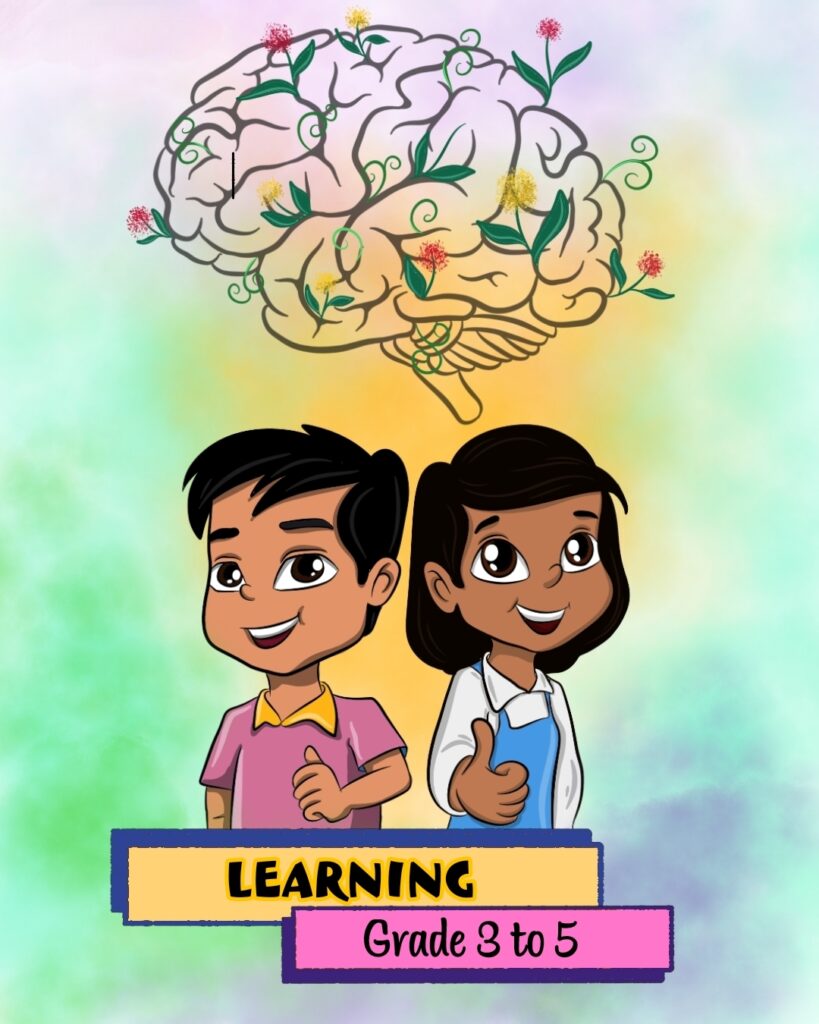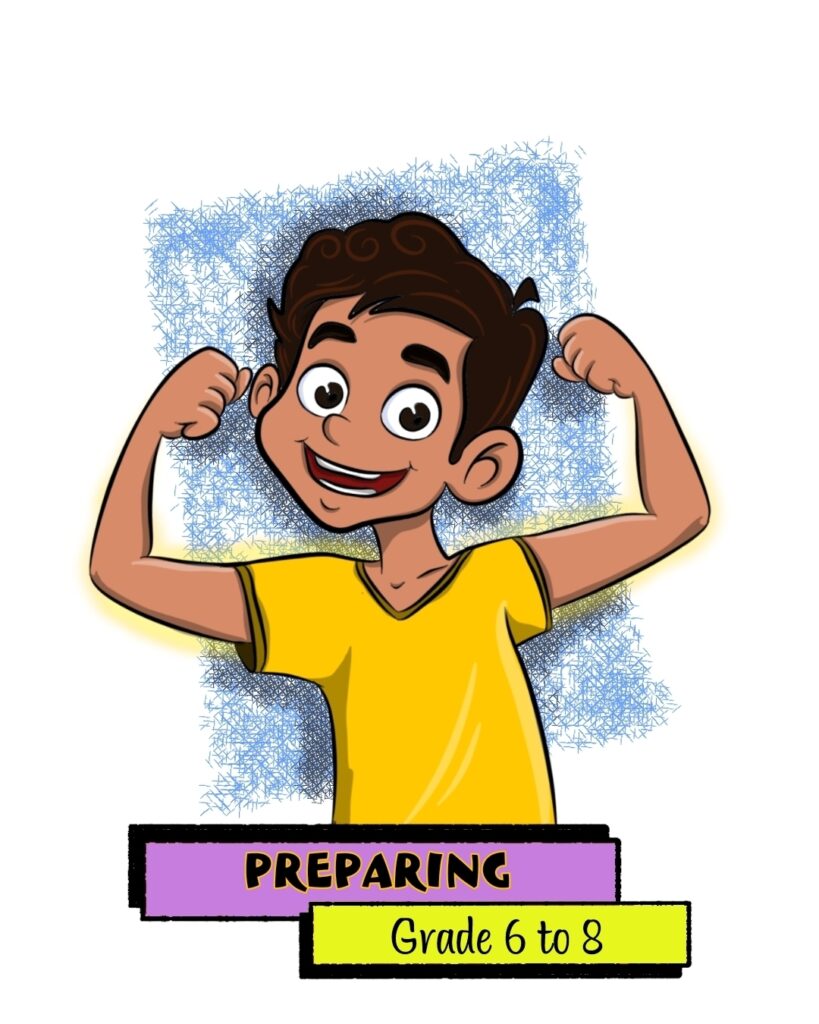Promoting Food and Nutrition
According to the Global Nutrition Report 2020, India has the highest burden of child malnutrition in the world, with nearly 50% of Indian children under the age of five being undernourished.
Teaching about food and nutrition at a young age helps in building healthy habits, promoting physical growth, enhancing cognitive function and Preventing food-related illnesses.
Teaching young kids about food and nutrition is crucial for promoting healthy growth and development, reducing the burden of malnutrition, and preventing chronic diseases later in life.
By providing children with accurate information about proper nutrition and healthy eating habits, we can help to ensure that they know about the nutrients they need to thrive and lead healthy lives.
In our classes on promoting food and nutrition, we enable students to
- Understanding Food and Nutrition
- Follow a healthy eating pattern that meets individual preferences and needs for growth and development.
- Choose a variety of options within each food group and eat lots of fruits and vegetables.
- Choose to eat whole grain products.
- Choose to drink or eat fat-free or low-fat dairy or fortified dairy alternatives.
- Drink lots of water and avoid sugary drinks.
- Limit foods high in added sugars, saturated fats, trans fats, and sodium.
- Choose to eat or drink nutrient-dense foods and beverages when dining.
- Prepare good-tasting, nutrient-dense foods for yourself and others.
- Choose and enjoy nutrient-dense foods and beverages that reflect personal preferences, culture, and budget.
- Support healthy eating patterns for others.
Each lesson is designed meticulously with the help of global experts, our classes are not only age-appropriate but also culturally appropriate according to the region and state you are watching the classes in. We also customize the classes to fit the requirements of each school.
We are ZatchUp and we are dedicated to empowering your child to make healthy and safe life choices.
Grade wise learning objective
KG – Grade 2
- Step 1 : Understaning the Core Concept : We enable Students comprehend core concepts related to our all health and saftely courses such as concent, violence prevention
- Explain the importance of trying new foods.
- Discuss the importance of people trying food several times before deciding if they like it.
- Explain the importance of choosing nutrient-dense foods and beverages that help people feel good.
- Explain the importance of eating different foods from all the food groups.
- Identify a variety of healthy, good-tasting, nutrient-dense snacks.
- Identify the benefits of drinking water.
- Describe the types of foods and beverages that should be limited (e.g., sugary drinks).
- Describe the benefits of eating breakfast every day.
- Describe how to keep food safe from harmful germs.
- Describe what it feels like to be hungry and full.
- Identify healthy eating patterns that provide energy and help the body grow and develop.
- Explain what is enjoyable about eating meals with family and friends.
- Step 2 : Second step is to Understand Influences : We enable Students to analyze the influence of family, peers, culture, media, technology, and other factors on their health and Safety.
- Identify how family can influence food choices and other eating practices and behaviors.
- Identify how school personnel can influence food choices and other eating practices and behaviors.
- Identify how media and technology can influence food choices and other eating practices and behaviors.
- Explain that the purpose of food advertisements (e.g., commercials, billboards, sponsored content, and product placement) is to make people want to eat more of certain foods.
- Describe positive influences on food choices and other eating practices and behaviors.
- Describe negative influences on food choices and other eating practices and behaviors.
- Step 3 : Third step is to learn to access Information : We enable students how to access valid information, products, and services to ensure good health and their safety.
- Identify trusted adults at home who can help promote healthy eating practices and behaviors.
- Identify trusted adults and professionals in school (e.g., classroom teacher, school nurse) who can help promote healthy eating practices and behaviors.
- Identify trusted adults and professionals in the community (e.g., registered dietitian, healthcare provider) who can help promote healthy eating practices and behaviors.
- Step 4: Fourth step is to learn Interpersonal Communication : We enable students to use interpersonal communication skills to enhance health and reduce all health risks.
- Demonstrate effective refusal skills to avoid unhealthy food choices and promote a healthy eating pattern.
- Demonstrate how to ask for food in response to internal hunger signals.
- Step 5 : Fifth step is to learn to make decision : We enable students to use decision-making skills to enhance healthly behaviour.
- Identify situations that need a food- and nutrition-related decision.
- Identify how family, peers, culture, technology, or media influence a food- and nutrition-related decision.
- Explain the potential positive and negative outcomes from a food- and nutrition-related decision.
- Describe when help is needed and when it is not needed to make a food- and nutrition-related decision.
- Step 6 : Sixth step is to learn to Set Goals : We enable Students to set right goals to enhance their health and keeping themselves safe.
- Identify a realistic personal short-term goal to improve eating patterns (e.g., try new fruits, vegetables, and whole grains; drink more water).
- Take steps to achieve a personal goal to improve eating patterns.
- Identify people who can help achieve a personal goal to improve eating patterns.
- Step 7 : Seventh Step is learn Self-Management : We enable students to practice health-enhancing behaviors and reduce health risks.
- Identify practices that reduce or prevent unhealthy eating patterns and behaviors.
- Demonstrate healthy eating patterns and behaviors.
- Commit to practicing healthy eating patterns and behaviors.
- Step 8 : Eigth step is learn to Advocate : We enable Students to advocate not only for personal, but also for family, and community health.
- Make requests to others (e.g., family members) about preferences for healthy eating patterns.
- Demonstrate how to encourage peers to make healthy food and beverage choices.
Grade 3 – Grade 5
- Step 1 : Understanding the Core Concept : We enable Students comprehend core concepts related to our all health and saftely courses such as concent, violence prevention
- Explain the importance of trying new foods.
- Name the food groups and a variety of nutritious food and beverage choices for each food group.
- Describe the components of a healthy meal.
- Describe the benefits of eating plenty of whole fruits and vegetables (e.g., fresh, canned frozen, and dried).
- Explain the importance of eating a variety of foods from all the food groups.
- Describe the benefits of consuming enough water.
- Identify sugary drinks.
- Identify foods that are high in added sugars, sodium, and saturated or trans fat.
- Identify sources of healthy fats (e.g., unsaturated fats and oils).
- Describe the health benefits of limiting the consumption of saturated or trans fat, added sugar, and sodium.
- Describe how to make or choose good-tasting, nutrient-dense snacks.
- Explain why breakfast should be eaten every day.
- Describe methods to keep food safe from germs.
- Explain the concept of eating the amount of food needed to be healthy and energetic.
- Describe the benefits of following a healthy eating pattern.
- Describe what it feels like to be hungry and full.
- Explain what is enjoyable about eating meals with family and friends.
- Step 2 : Second step is to Understand Influences : We enable Students to analyze the influence of family, peers, culture, media, technology, and other factors on their health and Safety.
- Identify how culture influences food choices and other eating practices and behaviors.
- Identify how peers influence food choices and other eating practices and behaviors.
- Identify how community influences food choices and other eating practices and behaviors.
- Describe how family and culture influence food choices and other eating practices and behaviors.
- Describe how school and community settings influence food choices and other eating practices and behaviors.
- Describe how media and technology influence food choices and other eating practices and behaviors.
- Explain that the purpose of food advertisements (e.g., product placement, commercials, billboards, sponsored content) is to make people want to eat more of that food.
- Describe how peers influence food choices and other eating practices and behaviors.
- Step 3 : Third step is to learn to access Information : We enable students how to access valid information, products, and services to ensure good health and their safety.
- Describe characteristics of valid nutrition information.
- Describe characteristics of food advertising.
- Demonstrate how to locate sources of valid nutrition information.
- Step 4: Fourth step is to learn Interpersonal Communication : We enable students to use interpersonal communication skills to enhance health and reduce all health risks.
- Demonstrate effective verbal and nonverbal communication to avoid unhealthy food choices and promote healthy eating.
- Demonstrate how to ask for food in response to internal hunger signals.
- Explain how to be empathetic and compassionate towards a family member who is trying to improve personal food choices.
- Demonstrate how to effectively ask for help to improve personal food choices.
- Step 5 : Fifth step is to learn to make decision : We enable students to use decision-making skills to enhance healthly behaviour.
- Identify situations which need a decision related to food and nutrition (e.g., when a peer offers a soft drink).
- Decide when help is needed and when it is not needed to make a decision related to food and nutrition.
- Explain how family, culture, peers, technology, or media influence a decision related to food and nutrition.
- Identify options and their potential outcomes when choosing foods and beverages.
- Choose a food or beverage that fits with a healthy eating pattern when making a decision about what to eat or drink.
- Describe the final outcome of a decision related to food and nutrition.
- Step 6 : Sixth step is to learn to Set Goals : We enable Students to set right goals to enhance their health and keeping themselves safe.
- Identify a realistic personal short-term goal to improve eating patterns (e.g., try new fruits, vegetables, and whole grains; drink more water).
- Track progress toward achieving a personal goal to improve eating patterns.
- Identify resources that can help achieve a personal goal to improve eating patterns.
- Step 7 : Seventh Step is learn Self-Management : We enable students to practice health-enhancing behaviors and reduce health risks.
- Describe practices and behaviors that reduce or prevent unhealthy eating patterns and behaviors.
- Demonstrate healthy eating patterns and behaviors.
- Commit to practicing healthy eating patterns and behaviors.
- Step 8 : Eigth step is learn to Advocate : We enable Students to advocate not only for personal, but also for family, and community health.
- Give factual information to improve the food and beverage selections of others.
- State personal beliefs to improve the food and beverage selections of others.
- Demonstrate how to persuade others to make healthy food and beverage choices.
Grade 6 – Grade 8
- Step 1 : Understanding the Core Concept : We enable Students comprehend core concepts related to our all health and saftely courses such as concent, violence prevention
- Explain the importance of trying new foods.
- Describe the importance of eating a variety of foods to meet daily nutrient and energy needs.
- Describe the Dietary Guidelines for their country.
- Summarize a variety of nutrient-dense food choices for each food group.
- Explain why individuals may have different nutritional needs.
- Summarize the benefits of eating plenty of whole fruits and vegetables (e.g., fresh, canned, frozen, and dried).
- Explain the similarities and differences in nutritional value and food sources for protein, fats, and carbohydrates.
- Identify foods that provide key nutrients including fiber, iron, calcium, potassium, and vitamin D.
- Identify how different stages of food processing can impact the nutrient profile of food.
- Identify examples of whole grain foods.
- Describe how to make good-tasting, nutrient-dense meals and snacks.
- Summarize the benefits of consuming enough water.
- Identify sugary drinks.
- Summarize the benefits of limiting the consumption of saturated fat, trans fat, added sugar, and sodium.
- Identify ways to prepare and season food using healthy fats, herbs, and spices while reducing sugar and sodium.
- Describe the importance of eating breakfast every day.
- Explain the relationship between access to healthy foods and personal food choices.
- Explain how to select nutrient-dense foods when dining out.
- Describe major chronic diseases and their relationship to eating and physical activity patterns.
- Analyze the benefits of following a healthy eating pattern.
- Identify healthy and risky approaches to weight management.
- Describe the benefits of eating the amount of food needed to be healthy and energetic.
- Describe body signals that tell a person when they are hungry and when they are full.
- Explain what is enjoyable about eating meals with family and friends.
- Step 2 : Second step is to Understand Influences : We enable Students to analyze the influence of family, peers, culture, media, technology, and other factors on their health and Safety.
- Explain how school rules, community norms, and public health policies or laws (e.g., food safety guidelines) influence food choices and other eating practices and behaviors.
- Explain how perceptions of norms influence healthy and unhealthy food choices and other eating practices and behaviors.
- Explain how social expectations influence healthy and unhealthy food choices and other eating practices and behaviors.
- Explain how personal values and beliefs influence food choices and other eating practices and behaviors.
- Describe how some health risk behaviors influence the likelihood of engaging in unhealthy eating practices and behaviors.
- Analyze how relevant influences of family and culture influence food choices and other eating practices and behaviors
- Analyze how relevant influences of school and community influence food choices and other eating practices and behaviors.
- Analyze how media and technology influence food choices and other eating practices and behaviors.
- Analyze how food advertisements (e.g., product placement, commercials, billboards, sponsored content) make people want to eat more of that food.
- Analyze how peers influence food choices and other eating practices and behaviors.
- Step 3 : Third step is to learn to access Information : We enable students how to access valid information, products, and services to ensure good health and their safety.
- Analyze the validity of nutrition information (e.g., differentiate between scientifically or medically accurate content and advertising, including sponsored content).
- Analyze the validity of nutrition products (e.g., dietary supplements, cleanses, detox).
- Describe situations that call for professional nutrition services.
- Access valid nutrition information from home, school, or community.
- Identify false or misleading claims on food packaging and promotions.
- Step 4: Fourth step is to learn Interpersonal Communication : We enable students to use interpersonal communication skills to enhance health and reduce all health risks.
- Demonstrate the use of effective verbal and nonverbal communication to choose foods that align with a healthy eating pattern.
- Demonstrate how to ask for food in response to internal hunger signals.
- Demonstrate effective peer resistance skills to avoid or reduce exposure to unhealthy food choices.
- Demonstrate effective negotiation skills to avoid or reduce unhealthy food choices.
- Demonstrate how to effectively ask for assistance to improve personal food choices and eating behaviors.
- Demonstrate how to effectively communicate empathy and support for others who are trying to improve personal food choices.
- Step 5 : Fifth step is to learn to make decision : We enable students to use decision-making skills to enhance healthly behaviour.
- Identify circumstances that help or hinder making choices that support a healthy eating pattern.
- Determine when situations require a decision related to a healthy eating pattern.
- Distinguish when a decision related to food and beverage choices should be made individually or with the help of others.
- Explain how family, culture, technology, media, peers and personal beliefs affect a decision related to eating behaviors.
- Distinguish between healthier and less healthy alternatives of a decision related to eating behaviors.
- Predict the potential outcomes of healthy and unhealthy alternatives of a decision related to eating behaviors.
- Choose a food or beverage that fits with a healthy eating pattern when making a decision about what to eat or drink.
- Analyze the effectiveness of a final outcome of a decision related to food and nutrition.
- Step 6 : Sixth step is to learn to Set Goals : We enable Students to set right goals to enhance their health and keeping themselves safe.
- Assess personal eating practices.
- Set a realistic personal goal to improve eating patterns.
- Assess the barriers to achieving a personal goal to improve eating patterns.
- Apply strategies to overcome barriers to achieving a personal goal to improve eating patterns.
- Use strategies and skills to achieve a personal goal to improve eating patterns.
- Step 7 : Seventh Step is learn Self-Management : We enable students to practice health-enhancing behaviors and reduce health risks.
- Explain the importance of being responsible for the personal eating behaviors that are within one’s control.
- Analyze eating patterns and behaviors that reduce or prevent health risks.
- Demonstrate eating patterns and behaviors to improve the health of oneself and others.
- Commit to practicing healthy eating patterns and behaviors.
- Step 8 : Eigth step is learn to Advocate : We enable Students to advocate not only for personal, but also for family, and community health.
- State a food and nutrition position, supported with accurate information, to improve the health of others.
- Persuade and support others to make positive food and beverage choices that are within their control and influence.
- Collaborate with others to advocate for healthy food and nutrition at home, in school, or in the community.
- Demonstrate how to adapt food and nutrition messages for different audiences.
Grade 9 – Grade 12
- Step 1 : Understanding the Core Concept : We enable Students comprehend core concepts related to our all health and saftely courses such as concent, violence prevention
- Describe the recommendations of the Dietary Guidelines for their country.
- Describe the relationship between diet and chronic diseases such as heart disease, cancer, diabetes, hypertension, and osteoporosis.
- Explain how the Dietary Guidelines for their country are useful in planning a healthy eating pattern.
- Identify food sources that provide key nutrients including fiber, calcium, potassium, iron, and vitamin D.
- Describe the importance of choosing a variety of foods and beverages to meet daily nutrient and energy needs.
- Explain the importance of trying new foods.
- Identify how different stages of food processing can impact the nutrient profile of food.
- Describe a balanced vegetarian eating pattern.
- Identify ways to prepare and season food using healthy fats, herbs, and spices while reducing sugar and sodium.
- Describe how to make good-tasting, nutrient-dense meals and snacks.
- Summarize the physical, mental, social, and academic benefits of eating breakfast every day.
- Summarize how to identify nutrient-dense food selections when dining out.
- Describe the benefits of avoiding energy drinks.
- Summarize the relationship between access to food and personal food choices.
- Summarize food safety strategies that can control germs that cause foodborne illnesses.
- Describe the relationship between nutrition and overall health.
- Identify characteristics of a “fad diet.”
- Analyze healthy and risky approaches to weight management.
- Describe body signals that tell a person when they are hungry and when they are full.
- Explain the effects of eating disorders on healthy growth and development.
- Identify signs of eating disorders.
- Analyze the benefits of healthy eating patterns.
- Describe the benefits of eating meals with family and friends.
- Step 2 : Second step is to Understand Influences : We enable Students to analyze the influence of family, peers, culture, media, technology, and other factors on their health and Safety.
- Explain how public health policies and guidelines influence food choices and other eating practices and behaviors.
- Analyze how culture supports and challenges beliefs, practices, and behaviors related to food and beverage choices.
- Analyze how peers and perceptions of norms influence healthy and unhealthy food choices and other eating practices and behaviors.
- Analyze how personal attitudes, values, and beliefs influence food choices and other eating practices and behaviors.
- Analyze how laws, rules, and regulations influence food choices and other eating practices and behaviors.
- Analyze how school and community affect food choices and other eating practices and behaviors.
- Analyze how food advertisements (e.g., product placement, commercials, billboards, sponsored content) make people want to eat more of that food.
- Analyze how media and technology influence personal, family, and community food choices and other eating practices and behaviors.
- Differentiate relevant influences, including family, culture, peers, school, community, media, technology, and public health policies on food choices and other eating practices and behaviors.
- Analyze the factors that influence opportunities to obtain safe, accessible, equitable, and affordable opportunities for healthy eating practices and behaviors for oneself and others.
- Step 3 : Third step is to learn to access Information : We enable students how to access valid information, products, and services to ensure good health and their safety.
- Evaluate the validity of nutrition information (e.g., differentiate between scientifically or medically accurate content and advertising, including sponsored content).
- Evaluate the validity of nutrition products (e.g., dietary supplements, “cleanses”, “detox”).
- Evaluate the validity of nutrition services (e.g., credentialed professionals, food assistance programs).
- Determine the accessibility of valid nutrition products.
- Determine when professional nutrition services may be required.
- Determine the accessibility of valid nutrition services.
- Use resources that provide valid nutrition information.
- Use valid nutrition products when needed or appropriate.
- Use valid nutrition services when needed or appropriate.
- Identify false or misleading claims on food packaging and promotions.
- Step 4: Fourth step is to learn Interpersonal Communication : We enable students to use interpersonal communication skills to enhance health and reduce all health risks.
- Demonstrate effective communication skills to improve personal food choices and healthy eating behaviors.
- Demonstrate effective peer resistance, negotiation, and collaboration skills to avoid unhealthy food choices.
- Demonstrate how to effectively ask for assistance to improve personal food choices and eating behaviors.
- Demonstrate how to effectively support others in improving food choices and eating behaviors.
- Step 5 : Fifth step is to learn to make decision : We enable students to use decision-making skills to enhance healthly behaviour.
- Examine barriers to making a decision related to food and nutrition.
- Justify when individual or collaborative decision making related to food and nutrition is appropriate.
- Analyze how family, culture, technology, media, peers, and personal beliefs affect a decision related to food and nutrition.
- Generate alternatives when making a decision related to eating behaviors.
- Predict the potential short- and long-term consequences of alternatives to decisions related to food and nutrition.
- Choose a food or beverage that fits with a healthy eating pattern when making a decision about what to eat or drink.
- Evaluate the effectiveness of decisions related to food and nutrition.
- Step 6 : Sixth step is to learn to Set Goals : We enable Students to set right goals to enhance their health and keeping themselves safe.
- Assess personal eating practices and behaviors.
- Set a realistic personal goal related to improve eating patterns.
- Assess the barriers to achieving a personal goal to improve eating patterns.
- Develop a plan to attain a personal goal to improve eating patterns.
- Implement strategies, including self-monitoring, to achieve a personal goal to improve eating patterns.
- Use strategies to overcome barriers to be achieving a personal goal to improve eating patterns.
- Formulate a long-term plan to achieve a health goal to improve eating patterns.
- Step 7 : Seventh Step is learn Self-Management : We enable students to practice health-enhancing behaviors and reduce health risks.
- Analyze the role of individual responsibility in enhancing eating patterns and behaviors.
- Evaluate personal healthy eating patterns and behaviors that reduce or prevent health risks.
- Demonstrate healthy eating patterns and behaviors to improve the health of oneself and others.
- Commit to practicing healthy eating patterns and behaviors.
- Step 8 : Eigth step is learn to Advocate : We enable Students to advocate not only for personal, but also for family, and community health.
- Use peer and societal norms, based on accurate health information, to formulate a message that promotes healthy eating patterns and behaviors.
- Use knowledge of available, valid services and health risks of disordered eating to seek professional support for oneself or help peers.
- Persuade and support others to make positive choices related to food and nutrition.
- Collaborate with others to advocate for improving personal, family, and community food and nutrition.
- Encourage school and community environments to promote healthy eating patterns and behaviors.
- Adapt food and nutrition messages and communication techniques to reach a specific target audience.
- Persuade school and community leaders about the importance of ensuring there are safe, accessible, equitable, and affordable nutrition opportunities, products, and services to improve the health of oneself and others.







